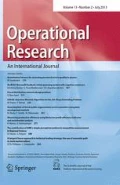Abstract
Personalized profiles that describe user behaviour and preferences are encountered in many applications, ranging from recommender systems or user agents (Web browsers) to one-to-one marketing. User profiling is a crucial step in providing accurate product recommendations to the end users. Once groups of people with similar preferences are identified, information, products, or services tailored to group’s needs, can be delivered. The aim of this paper is to clarify the role of utility functions in the formation of user profiles. Thus, the clustering behaviour of customers’ preferences is investigated by means of clustering algorithms and preference modelling. It is shown in this work that the incorporation of a Multi-criteria methodology prior to the application of a clustering algorithm constitutes a fundamental step for the formation of more accurate user profiles in terms of compactness and separation of the groups.






Similar content being viewed by others
References
Adomavicius G, Tuzhilin A (2005) Personalization Technologies: A Process-Oriented Perspective. Communications of the ACM 48(10)
Figueira J, Greco S, Ehrgott M (eds) (2005) Multiple criteria decision analysis: state of the art surveys. Springer, Boston
Halkidi M, Batistakis Y, Vazirgiannis M (2002a) Cluster validity methods: Part I. SIGMOD Rec 31(2):40–45
Halkidi M, Batistakis Y, Vazirgiannis M (2002b) Clustering validity checking methods: Part II. SIGMOD Rec 31(3):19–27
Jacquet-Lagrèze E, Siskos Y (1982) Assessing a set of additive utility functions for multicriteria decision making: the UTA method. Eur J Oper Res 10(2):151–164
Keeney RL, Raiffa H (1993) Decisions with multiple objectives-preferences and value tradeoffs. Cambridge University Press, London
Likas A, Vlassis N, Verbeek J (2003) The global k-means clustering algorithm. Pattern Recognit 36(2):451–461
MacQueen JB (1967) Some methods for classification and analysis of multivariate observations. In: 5th Berkeley Symposium on Mathematical Statistics and Probability, Berkeley, University of California Press
Öztürk M, Tsoukiàs A, Vincke Ph (2005) Preference modelling. In: Ehrgott M, Greco S, Figueira J (eds) State of the art in multiple criteria decision analysis, Springer, Boston, pp 27–72
Roy B (1985) Méthodologie Multicritère d’Aide à la Décision. Economica
Siskos Y, Yannacopoulos D (1985) UTASTAR, An ordinal regression method for building additive value functions. Invest Oper 5(1):39–53
Siskos Y, Matsatsinis NF (1993) A DSS for market analysis and new product design. J Decis Syst 2(1):35–60
Siskos Y, Grigoroudis E, Matsatsinis N (2005) UTA methods. Multiple criteria decision analysis: state of the art surveys. Figueira J, Greco S, Ehrgott M. Springer, Boston, pp 297–344
Tan P-N, Steinbach M, Kumar V (2006) Cluster analysis: basic concepts and algorithms. Introduction to data mining. Addison-Wesley, Reading
Wedel M, Kamakura W (2000) Market segmentation: conceptual and methodological foundations. Kluwer, Dordrecht
Zopounidis C, Doumpos M (2002) Multicriteria classification and sorting methods: a literature review. Eur J Oper Res 138(2):229–246
Acknowledgments
The authors are grateful to professors, M. Doumpos, N. Vlassis and A. Doulamis who contributed their time and knowledge to this work and also to the anonymous referees for their valuable comments. This work is part of the 03ED375 research project, implemented within the framework of the “Reinforcement Programme of Human Research Manpower” (PENED) and co-financed by National and Community Funds (75% from E.U.-European Social Fund and 25% from the Greek Ministry of Development-General Secretariat of Research and Technology).
Author information
Authors and Affiliations
Corresponding author
Rights and permissions
About this article
Cite this article
Lakiotaki, K., Delias, P., Sakkalis, V. et al. User profiling based on multi-criteria analysis: the role of utility functions. Oper Res Int J 9, 3–16 (2009). https://doi.org/10.1007/s12351-008-0024-4
Received:
Accepted:
Published:
Issue Date:
DOI: https://doi.org/10.1007/s12351-008-0024-4




